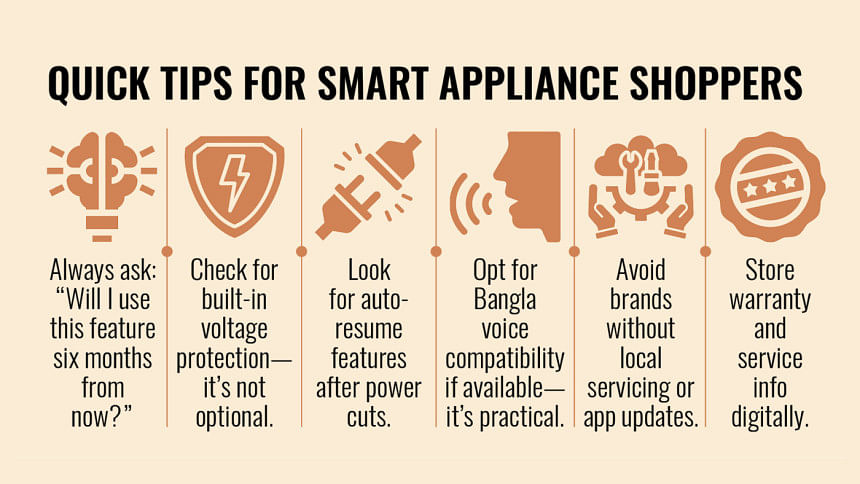The smart shopper’s checklist

Buying smart home appliances nowadays can feel like stepping into a minefield of QR codes, blinking LEDs, and tech jargon. One moment, you're just looking for a fridge that texts you when it's low on eggs, and the next, you're stuck in a rabbit hole of compatibility charts and subscription-based features.
In a market flooded with gadgets labelled as "smart," how do you make sure you're not buying an overpriced, overhyped toaster that's obsolete in two years? Welcome to the smart shopper's checklist—a reality check for those navigating the future of home living without losing their money, mind, or WiFi connection.
Start with your lifestyle, not the latest features
Every household is different, and that's where your journey should begin—not with a list of features, but with an honest look at how you live.
Tanvir Anjum, Business Coordinator to the Managing Director of Walton Hi-Tech Industries, describes it clearly, "Smart home appliances basically mean AI-incorporated or IoT-integrated devices. It's about connectivity—your phone being connected to your AC, your fridge, your alarm clock, even your door lock. You're five minutes from home, and you can turn on the AC, the lights, maybe even play your preferred music. That's what makes it smart."
The smartest appliance isn't the one with the most bells and whistles—it's the one that integrates effortlessly into your day-to-day life. Don't be swayed by shiny packaging or futuristic demos. Begin by identifying your pain points and picking devices that address them directly.
Local conditions matter more than you think
Most global smart devices are built assuming stable infrastructure—steady electricity, clean water lines, good insulation, and flawless WiFi. These assumptions don't always hold true everywhere in Bangladesh, where voltage spikes can damage sensitive electronics, and internet dropouts are routine. In these conditions, how "smart" a device is depends on how well it adapts to your environment.
Before making a purchase, check if the appliance has built-in voltage protection or auto-resume features after power failures. A smart fridge that resets its settings after every outage can become a daily frustration. Similarly, an app-controlled geyser might look great until the WiFi fails and no one at home knows how to turn it on manually. Always think in terms of backup functionality, especially in a country where infrastructure can be unpredictable.
Don't pay for gimmicks
One of the biggest traps in smart appliance marketing is the emphasis on gimmicky features that look impressive but serve little real purpose. "AI wash," "smart diagnosis," and "energy-aware cycles" sound innovative, but are often marketing repackagings of basic functionalities. A feature is only "smart" if it adds measurable value to your routine.
When evaluating features, ask yourself if you'll still use it six months down the line. If not, it's probably not worth paying for. That's why homegrown innovation also matters. Walton, for instance, has been focusing on function-driven products.
As Anjum notes, "We launched the first voice-controlled AC in Bangladesh, and it even works in Bangla. You can turn it on from outside the home. Our smart fridges let you manage temperature and even lock the device remotely. Our TVs are Google TV and Android TV. We are integrating IoT across our entire product line."
Choose brands that think long-term
Software support is an often-overlooked issue in the smart appliance world. Many devices depend on periodic software updates to remain functional, secure, and compatible with newer tech. Unfortunately, some lesser-known or imported brands disappear from the market in a year or two, leaving their customers stuck with expensive hardware that no longer syncs with anything.
If you're buying a high-investment smart product, make sure the brand has a local footprint –authorised service centres, responsive customer support, and technicians trained to work with smart systems. Global giants like Samsung, LG, and Whirlpool typically have stronger after-sales support networks in Bangladesh. But local manufacturers are not far behind – on the contrary, they are actively innovating and making their presence felt across all segments.
Monika Islam, Group Director of Jamuna Group, underscores this shift: "Domestic brands like Jamuna have built a strong position among consumers, leaving behind foreign brands. The electronics industry, which was once completely dependent on imports, is now dominated by domestic companies."
The rise of locally manufactured smart appliances is not just a sign of self-sufficiency – it's also a way for buyers to access innovation that's tailored for the Bangladeshi lifestyle and climate.
Local support should be part of your decision
Many Bangladeshi buyers overlook one crucial element: what happens if the product breaks? Imported gadgets may come with great features, but limited or no local servicing. That smart oven from an online store might seem like a steal—until something goes wrong and there's no technician qualified to fix it.
Always ask where the service centre is located. Is there support in your city? How long do repairs typically take? Are there spare parts available locally? It's also smart to photograph and digitally store your warranty papers—service providers in Bangladesh often "misplace" hard copies.

 For all latest news, follow The Daily Star's Google News channel.
For all latest news, follow The Daily Star's Google News channel. 



Comments